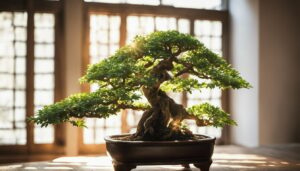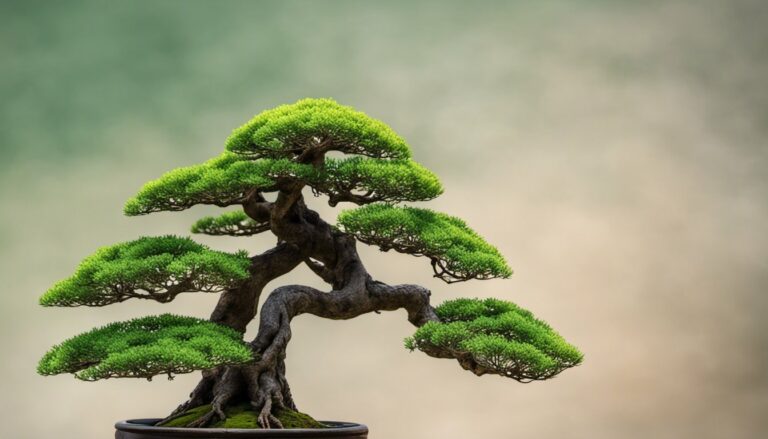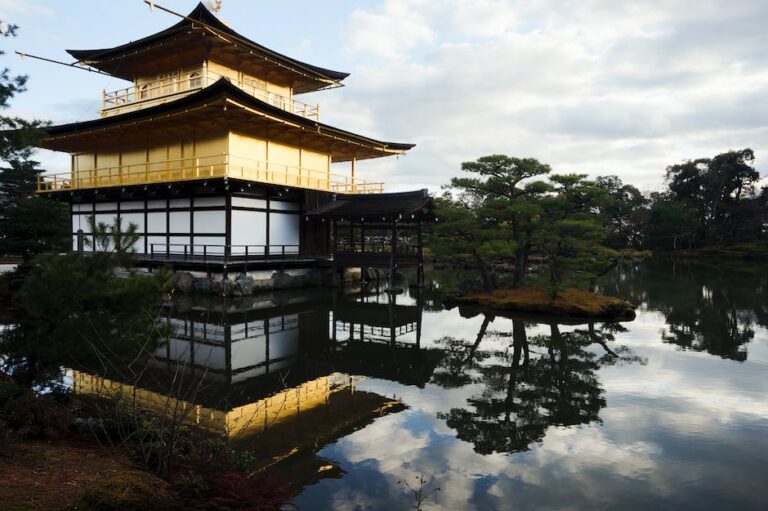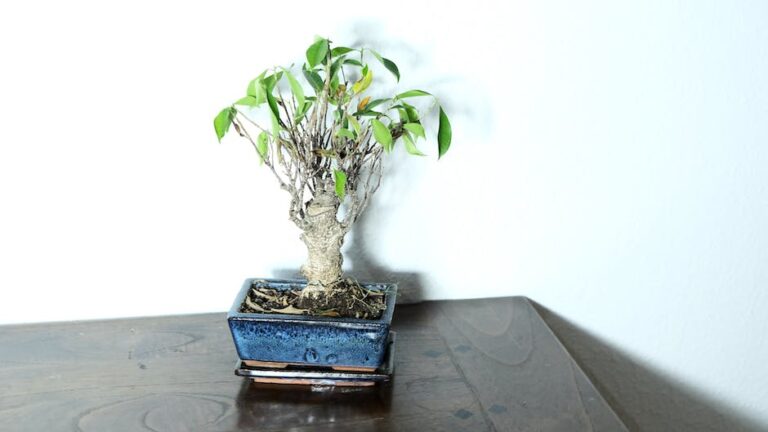Are Bonsai Trees Spiritual
Imagine stepping into a miniature world, where ancient trees stand as sentinels of wisdom and  tranquility. In this realm, bonsai trees beckon you to explore their spiritual essence.
tranquility. In this realm, bonsai trees beckon you to explore their spiritual essence.
Delve into the historical significance and symbolism of these carefully crafted living works of art. Discover the profound connection between bonsai trees and Zen Buddhism, as they become vessels for meditation and contemplation.
Embark on a journey of self-discovery, as you uncover the profound spiritual journey that lies within the care of these exquisite bonsai trees.
Key Takeaways
- Bonsai trees have a rich history and are considered a form of living art, admired for their beauty.
- Bonsai trees symbolize the harmony between man and nature, representing balance and surrender.
- Zen-inspired bonsai practices emphasize simplicity, mindfulness, and the interconnectedness of all things.
- Bonsai trees enhance meditation practice by cultivating patience, mindfulness, and tranquility, symbolizing impermanence and fostering acceptance.
Historical Significance of Bonsai Trees
The historical significance of bonsai trees can be traced back to ancient China and Japan. They were cultivated by monks and nobles for their spiritual and aesthetic value. Bonsai tree artistry has a rich history that spans centuries.
In both countries, bonsai trees were considered a form of living art. They were meticulously shaped and pruned to mimic the grandeur of nature in miniature form. The artistry behind bonsai trees involved intricate techniques such as wiring, pruning, and grafting to achieve the desired shape and aesthetic appeal.
Bonsai trees were not only admired for their beauty but also celebrated as symbols of harmony, balance, and patience. Their historical significance lies in their ability to captivate and inspire generations with their timeless elegance.
With this understanding, we can now explore the symbolism in bonsai tree artistry.
Symbolism in Bonsai Tree Artistry
Explore the intricate symbolism woven into the artistry of these miniature masterpieces.
Bonsai trees have long been associated with deep symbolism in their cultivation. The careful pruning and shaping of these trees represent the harmony between man and nature, as well as the balance between control and surrender. Each curve and twist of the branches signifies the passage of time and the wisdom gained through patience and perseverance.
Bonsai trees also hold psychological benefits for their caretakers. The process of tending to these trees requires mindfulness and focus, which can promote relaxation and reduce stress. The act of nurturing a living being, even on a small scale, can bring a sense of purpose and connection to the natural world.
The symbolism and psychological benefits of bonsai trees make them not only stunning works of art but also powerful tools for personal growth and introspection.
Connection Between Bonsai Trees and Zen Buddhism
When it comes to exploring the connection between bonsai trees and Zen Buddhism, there are two key points to consider.
Firstly, Zen-inspired bonsai practices emphasize the principles of simplicity, harmony, and mindfulness. These practices reflect the Zen philosophy of finding peace and beauty in the present moment. By cultivating bonsai trees in a Zen-inspired way, practitioners aim to create a sense of tranquility and balance in their lives.
Secondly, symbolism in bonsai art further deepens the connection between bonsai trees and Zen Buddhism. Each tree and its arrangement hold profound meanings and convey messages of balance, resilience, and the cycle of life. Through the careful shaping and arrangement of the tree, artists seek to capture the essence of nature and the interconnectedness of all things.
Zen-Inspired Bonsai Practices
Discover how Zen-inspired bonsai practices can enhance your spiritual connection and bring tranquility to your daily life.
Zen inspired gardening focuses on creating a harmonious and balanced environment, reflecting the principles of Zen Buddhism. Bonsai pruning is an essential aspect of this practice, offering numerous benefits for both the tree and the practitioner.
By carefully trimming the branches and roots of a bonsai tree, you promote its overall health and growth. This process allows you to shape the tree into a desired form, symbolizing unity and interconnectedness with nature.
As you engage in this meticulous practice, you cultivate patience, mindfulness, and a deep appreciation for the beauty of simplicity. The act of pruning becomes a meditative experience that enables you to connect with your inner self and find tranquility amidst the chaos of daily life.
Symbolism in Bonsai Art
Immerse yourself in the art of bonsai and uncover the profound symbolism hidden within its intricate designs. Bonsai, which translates to “tray planting,” is more than just a horticultural practice; it is a form of artistic expression that dates back over a thousand years. The miniature trees represent nature in its purest form, and each element has a symbolic meaning. To help you appreciate the symbolism in bonsai art, here is a table showcasing some common elements and their significance:
| Element | Symbolism |
|---|---|
| Shape | Balance and harmony |
| Trunk | Strength and resilience |
| Branches | Growth and development |
| Leaves | Life and vitality |
Bonsai Trees as Meditation Tools
If you’re looking for a unique way to enhance your meditation practice, bonsai trees can serve as excellent tools. These miniature trees not only add beauty to your space but also provide numerous benefits for your mindfulness practice.
Here are four reasons why bonsai trees can help deepen your meditation experience:
- Cultivating Patience: Bonsai trees require careful attention and nurturing, teaching you the art of patience and mindfulness as you tend to their needs.
- Connection with Nature: Bringing a bonsai tree indoors allows you to connect with nature on a daily basis, promoting a sense of calmness and tranquility.
- Focus and Concentration: Pruning and shaping a bonsai tree demands focus and concentration, helping you develop a single-pointed awareness during meditation.
- Symbolism of Impermanence: Bonsai trees embody the concept of impermanence, reminding us to appreciate the present moment and embrace change.
Bonsai Trees and the Concept of Impermanence
Incorporating bonsai trees into your meditation practice can remind you of the concept of impermanence and encourage you to embrace change.
The concept of mindfulness, rooted in Buddhist teachings, is all about being present in the moment and accepting the transient nature of life. Bonsai trees, with their intricate and delicate beauty, epitomize this idea.
As you sit in meditation, observing the bonsai tree’s elegant form and ever-changing foliage, you are reminded of the impermanence of all things. The delicate branches that you carefully prune and shape mirror the impermanence of our own lives.
This awareness can deepen your meditation practice, fostering a sense of acceptance and gratitude for the present moment.
Now, let’s explore the spiritual journey through bonsai tree care.
Exploring the Spiritual Journey Through Bonsai Tree Care
When it comes to bonsai tree care, understanding the symbolism behind these miniature trees is key. Bonsai trees have deep-rooted connections to Zen Buddhism, where they are seen as a representation of the beauty and harmony found in nature.
Through the meticulous process of shaping and nurturing a bonsai tree, practitioners can find a sense of peace and tranquility, making it a form of meditation in itself.
Bonsai Tree Symbolism
You might be interested to know that bonsai trees carry deep symbolism and are often associated with harmony, balance, and patience. These miniature trees have captivated people for centuries with their unique aesthetics and healing properties. Here are four aspects of bonsai tree symbolism that will surely pique your interest:
- Reflection of Nature: Bonsai trees are meticulously shaped to mimic the grandeur and beauty of nature. They serve as a reminder of the interconnectedness between humans and the natural world.
- Growth and Transformation: The art of bonsai involves carefully nurturing and shaping a tree over time. This process symbolizes personal growth, transformation, and the ability to adapt to change.
- Stillness and Serenity: Bonsai trees exude a sense of tranquility and calmness. They serve as a visual representation of finding inner peace and embracing the present moment.
- Timelessness: Bonsai trees can live for generations, passing down their wisdom and beauty through the ages. They symbolize the enduring nature of life and the wisdom that can be gained with age.
Understanding the symbolism behind bonsai trees allows us to appreciate their beauty on a deeper level. Now, let’s explore the connection between zen and bonsai.
Zen and Bonsai Connection
To understand the connection between zen and bonsai, it’s important to delve into the principles of mindfulness and simplicity.
Zen and mindfulness are deeply intertwined in the art of bonsai. Mindfulness is the practice of being fully present and aware of one’s thoughts and surroundings. Bonsai tree care techniques require a high level of mindfulness as every action, from pruning to watering, must be done with utmost attention and care. The act of tending to a bonsai tree becomes a meditation, a way to connect with nature and find inner peace.
Bonsai also embodies the principle of simplicity. Through careful pruning and shaping, the bonsai tree is transformed into a miniature representation of nature’s beauty. The process of creating and maintaining a bonsai tree encourages a simplified and mindful approach to life, promoting harmony and balance.
Meditation Through Bonsai
Meditation can be achieved through the practice of caring for a bonsai tree. Bonsai trees require attention and focus, making them the perfect medium for meditation.
Here are four meditation techniques you can incorporate into your bonsai tree care routine:
- Mindful watering: As you water your bonsai, focus on the sensation of the water flowing through your fingers. Pay attention to the sound it makes and the way it nourishes the tree.
- Pruning with intention: When pruning your bonsai, approach it with mindfulness. Each cut should be deliberate and purposeful, symbolizing the release of unnecessary thoughts and distractions.
- Gentle shaping: As you shape your bonsai, take the time to connect with the tree. Feel the branches and leaves in your hands, visualizing the desired form while staying present in the moment.
- Daily observation: Set aside a few minutes each day to observe your bonsai tree. Notice any changes, new growth, or signs of stress. This practice cultivates a sense of presence and gratitude.
Conclusion
In conclusion, bonsai trees are not just ordinary plants. They hold a deep spiritual significance that goes beyond their physical beauty.
Through their historical significance, symbolism, and connection to Zen Buddhism, bonsai trees serve as powerful meditation tools. They teach us about the concept of impermanence and guide us on a spiritual journey of self-discovery.
So, next time you encounter a bonsai tree, take a moment to appreciate its intricate beauty and let it inspire you on your own path of growth and enlightenment.





